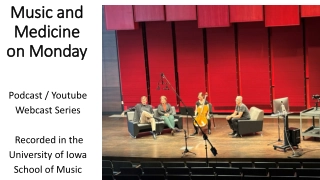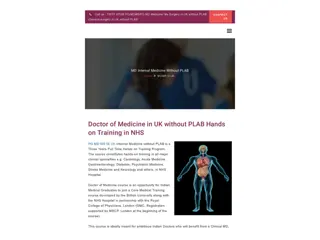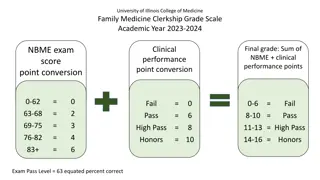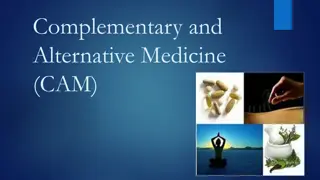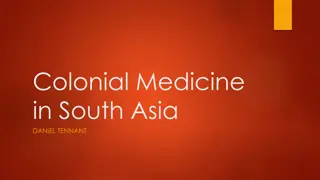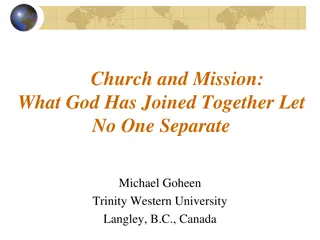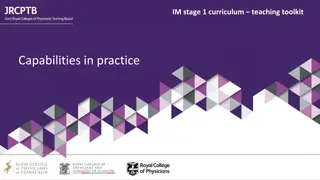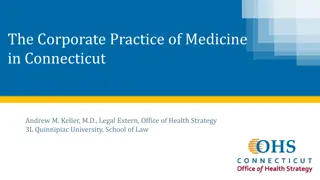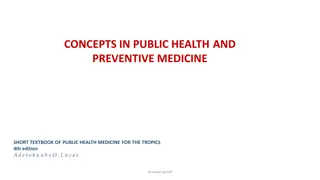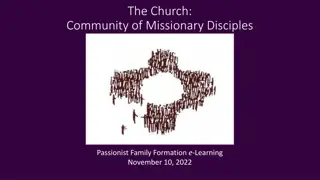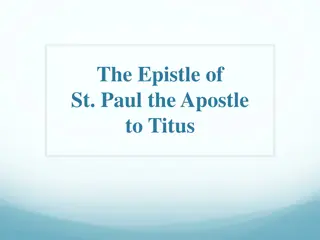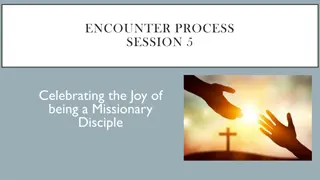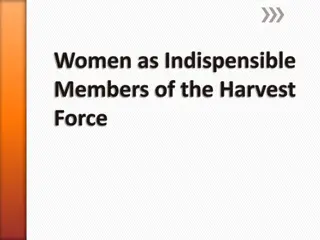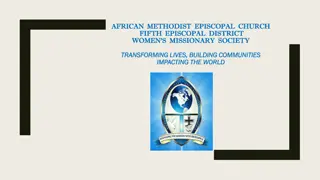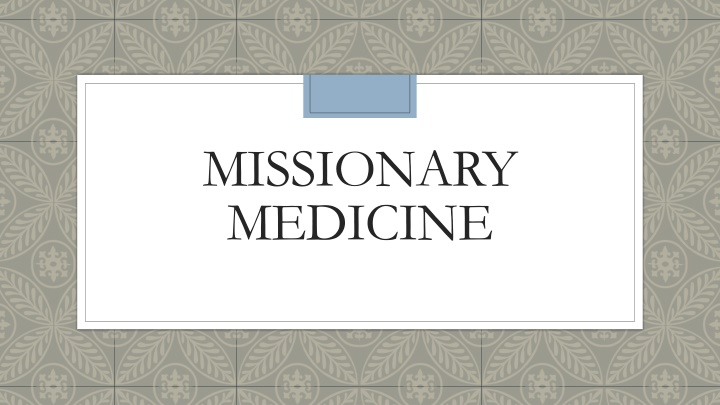
Evolution of Women Medical Missionaries in India from the 19th Century
Explore the historical evolution of women medical missionaries in India, from the early challenges faced in outreach to the significant impact of medical training on their mission work. Witness how societal changes, colonial influences, and economic shifts shaped missionary medicine over the years, reflecting the gendered nature of healthcare delivery in India.
Download Presentation

Please find below an Image/Link to download the presentation.
The content on the website is provided AS IS for your information and personal use only. It may not be sold, licensed, or shared on other websites without obtaining consent from the author. If you encounter any issues during the download, it is possible that the publisher has removed the file from their server.
You are allowed to download the files provided on this website for personal or commercial use, subject to the condition that they are used lawfully. All files are the property of their respective owners.
The content on the website is provided AS IS for your information and personal use only. It may not be sold, licensed, or shared on other websites without obtaining consent from the author.
E N D
Presentation Transcript
MISSIONARY MEDICINE
Rosemary Fitzgerald, 'A "Peculiar and Exceptional Measure": The Call for Women Medical Missionaries in India in the Later Nineteenth Century', in Robert A. Bickers and Rosemary Seton (eds.), Missionary Encounters: Sources and Issues, (Richmond: Curzon Press, 1996), pp. 174- 196. Before the 1860s, medical missionary work was deemed as a novel idea. There was little thought around the possibility of women becoming missionaries. The only exception to this were the female relatives of male missionaries, although this was more so to emotionally aid them. "Thus women were sent forth on missionary service, not to trespass on the male missionary's domain, but to carry out their own distinctive female mission: "the Mission of women to women in the homes, to the mothers and to the little children."". (p. 178) This way of thinking changed during the 1860s, unmarried women were encouraged to partake in missionary work. Their work was deemed necessary to reach Indian women, as they were seen as inaccessible for male missionaries to convert. These female missionaries were needed to approach women in the zenana. Even so, this was relatively unsuccessful. Particularly regarding households of high influence. Therefore, the medical training of missionary women was required. The medical missionary was accepted by all in society, as healthcare is a universal need. The majority of female patients were treated in their own homes, as there was an aversion to in-patient care. This meant that there was little time for female missionaries to spread the message of salvation. As fully qualified medical women arrived in India around the turn of the century, the number of in-patient cases did increase. Notably, around 1/3 of the students at the London School of Medicine for Women were studying for a missionary purpose.
Rama V. Baru, Ch. 10: Women Missionaries in Medical Care and Institution Building in India, in Lata Singh and Shashank Shekhar Sinha (eds.) Gender in Modern India, pp.223-240. Missionary work in the nineteenth and twentieth century was undertaken by British and American women with medical training to out to use skills that couldn t be done in their home countries due to the patriarchal societies limiting medical practices for women. The nature of missionary work changed over time from treatment-focused to navigating local politics and colonial bureaucracy to solicit donations. Alongside this missionary medical centres became training institutions for women to access basic training and enter auxiliary roles in missionary hospitals. These then went onto become formal medical institutions. Gender gets embedded in commercialization of healthcare. In fact, im- plications for gender are shaped by the socio- economic, patriarchal, and cultural contexts in which commercialization takes place. (p.238) The twentieth century changed the way missionary medicine was practiced due to the changes in economy and society. The interwar economic condition of the West meant there was a reduction in donations from home to keep the hospitals running, there was also a change in formal education that saw Indian medical colleges change from awarding licentiates to MBBS, which increased the cost of medical staff that the hospitals couldn t afford. Alongside changes to available funding was the loss of staff as societal changes in the US and UK meant there were better opportunities at home for work and no incentive to work abroad. Post-WW2 and Indian independence saw new investment into public health and institutions, including the takeover of some missionary hospitals. Missionary hospitals that remained were competing with public hospitals for patients, but they also couldn t compete with the new hospitals due to lack of funding and loss of revenue. Changes to public healthcare did not change the gendered nature of medicine in India, with doctors still being mostly male and nurses mostly female, with auxiliary roles being fulfilled with low or no wage work from women. 1970s to 1990s saw biggest change in medical institutions, including missionary hospitals, as medicine became increasingly commercialized in this period. For-profit institutions were being frequented by the strengthening middle class, and missionary hospitals couldn t compete with the new technology, specialized doctors and staffing levels that were becoming associated with quality services.
David Hardiman, Healing Bodies, Saving Souls: Medical Missions in Asia and Africa, (New York: Rodopi, 2006), 'Chapter 2: Seeking Souls through the Eyes of the Blind: The Birth The Birth of Medical Missionary Society in Nintetenth Century China', pp. 59-86. Foreign presence in China was particularly limited, their interactions were restricted to small areas of the country. Therefore, it was incredibly effective for missionaries to establish hospitals and dispensaries wherever they could. Dr. Colledge established an ophthalmic hospital as a medical missionary, by 1832 he had treated around 4,000 patients. This inspired other medical missionaries such as James H. Bradford to open their own dispensaries. Dr. Peter Parker opened his own practice in Canton in November 1835. He had originally settled in Singapore, however due to climate related health issues he had to move. This pleased Dr. Bridgman, who deemed it necessary for there to be a medical missionary in the Canton region. This practice was incredibly successful, leading to Parker, Bridgman and Colledge campaigning for an official Medical Missionary Society in China. This would create a permanent base in Canton alongside allowing for the missionary process to spread further. The directors of the American Board for missionaries began to complain that their representatives were too focused on the medical side of their task. There was little time for them to fulfil the religious aspect of their missionary duties. "for any medical missionary to be successful, he must be freed from the obligation of devoting too much time to the duties of preaching." (p. 71)
Megan Vaughan, Curing Their Ills: Colonial Power and African Illness (Cambridge: Polity, 1991), Ch. 3: The Great Dispensary in the Sky: Mission Medicine, pp. 54-70 Missionary medicine was the primary form of care to rural Africans until the late-twentieth century outside of great campaigns (i.e. Smallpox) Missionary medicine established rural hospitals and clinics in rural areas and trained African personnel to take on medical roles. Missionary medicine was explicitly non-secular in its messaging disease was a moral issue, people had individual responsibility over their sin and their disease. Missionary medicine was opportunistic, leaders saw the role of the sickbed as a place to evangelize such as David Lingstone and Albert Cook. Evangelizing people on their sickbeds was controversial on two fronts, the first was that medicine was seen as something that interfered with the evangelizing mission, the second was that those who converted at the end of their life were suspect and their conversion was superficial. Early missionary medicine in Central and East Africa was also not regarded how missionaries wanted it to be. Some Africans treated Western medicine the same as their native practices by combining the practical with their spiritual beliefs. The enthusiasm for Western medicine in rural Africa was also perceived negatively by missionaries who saw the enthusiasm from natives as embarrassing and indicative of moral inadequacy Mission hospitals were important to the evangelizing mission beyond the sickbed. Long-term sickness gave more opportunity to impart Christian teachings onto patients, the Christian imagery on the walls and the health improvements in a spiritual institution meant long-term sick patients were easier targets for conversion. This message wouldn t change even when staff didn t have time to evangelize to patients due to the strong associations made between religion and medicine over the decades. Secularization of medicine was a slow change over the early to mid twentieth century, as the colonial governments became increasingly critical of the evangelical role medical practitioners had, however secularization was not linear, and biomedicine and religion were sometimes at odds as missionaries saw the healing of the soul as above the healing of the body. The cultural construction of illness through biomedical discourse is a powerful tool of social control. The discourse of mission medicine in Africa utilized this powerful biomedical discourse, but allied it to a rather different and very directly moral and religious one. (p.67)
Esme Cleall, Missionary Discourses of Difference: Negotiating Otherness in the British Empire, 1840-1900 (Basingstoke: Palgrave, 2012), Ch. 3: Pathologising Heathenism: Discourses of Sickness and the Rise of Medical Missions, pp. 79-98 Sickness used as a tool of discourse to promote ideas of sympathy, pity and that anything considered diseased should be rescued either for moral reasons or actual disease outbreaks in an area. Sickness as a tool in discourse exemplified by its usage in religion such as blindness as a metaphor for sinfulness and the racialised dimensions of enlightened white missionaries contrasted with dark spiritualities. Sickness and disability were used as heroic metaphors and would represent someone overcoming their illness, a non-Christian blind person was a representation of sinfulness, but a Christian blind person represented spiritual sightedness. The ways in which missionaries used language to construct sickness matter because the fluidity between using language to create heathenism and Christian renewal made the idea of the sick body a missionary site. Missionary medicine expanded in the late nineteenth and early twentieth centuries. Neyoor hospital had 33 beds, saw 957 inpatients and 41,363 outpatients a year which was higher attendance than other missionary institutions. Treatment combined Western medicine with proselytising. Medical missionary institutions promoted spirituality in healing, patients would be read bible passages in care and their medical cards recommended scripture as part of their daily routine as outpatients. Medical work across global missionary institutions was fractured. London missionary society concentrated resources in the East and sent untrained missionaries to practice in Africa, this discrepancy was explained as strategical with medical help being sent where other evangelisation efforts had failed. Missionary workers were also more inclined to work in India than Africa as India was viewed as more severely ill. Medical missions thrived on the appearance and dissolution of differences - racial, moral and social differences were used to justify the superiority of missionaries. In India hospitals used Western practices to create difference between natives and missionaries - missionary hospitals were large sanitised buildings with lots of privacy where their patients were more used to small cramped rooms. African missionaries drew differences by being intuitively scientific compared to African medical men. In leprosy colonies missionaries would draw difference by claiming they were taking a scientific approach to curing their illness. These differences were constructed with the idea they would cease upon conversion to Christianity. Cleanliness, orderliness, treatment and prayer were combined in an overall process of healing. (p.86)
Questions Were medical missionaries ultimately able to balance their work as doctors alongside their duty to spread the word of Christianity? How did the work of missionaries vary depending on the country that they were located in?

